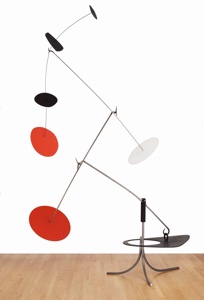Alexander Calder ( 1898 - 1976)
Trois noirs sur un rouge
1968
Painted sheet metal
© 2020 Calder Foundation, New York / Artists Rights Society (ARS), New York
Modern Art Gallery
Description of Trois Noirs Sur un Rouge
NARRATOR: The sculpture you are in front of is entitled Trois Noirs Sur un Rouge (which means Three Blacks Over Red in French) and was made of painted sheet metal by the artist Alexander Calder in 1968. It is 130 inches tall, 118 inches wide, and 86 5/8 inches deep and is displayed upon a white wooden circular base with a diameter roughly the length of your outstretched arms. It is an abstract mix of long lines created by silver metal bars and curving biomorphic shapes made of painted red, black, and white sheet metal.
This piece is a classic example of Calder’s standing mobiles. Although the term mobile implies movement, this sculpture is at rest.
Beginning at the bottom, three legs, gently curving inward into one line, rise up through a circular hole about the size of a standard bathroom sink cut through a rounded, black shape that loosely resembles a giant guitar pick. This shape is not directly touching the stand, making it appear to float unsupported in the air. Upon closer inspection, however, we see it is attached to the rest of the sculpture from the top by a round hook and loop and that the weight of the rest of the sculpture pulling upward from this hook is allowing the shape to remain fixed in the air, perfectly flat and balanced.
Continuing up the sculpture, we see the hook is actually the end of a long, thin, metal bar that slants upward in the direction of 10 o’clock for about a foot to where it intersects with the top of the tripod stand before continuing upward for roughly a yard. At the end of this bar is another hook, pointing upward. Balancing in the bend of this hook is a small triangular loop about the size of a balled up fist, attached to the middle of a second slightly thinner, metal bar slanted in the direction of 11 o’clock. The junction of the two bars forms angles like a “T” with a slanted top.
One side of the second bar slants downward in the direction of 5 o’clock for about a yard, with a red sheet metal circle about two feet in diameter capping the end. The other side of this bar slants upward in the direction of 11 o’clock for about a yard, ending with another pointed hook. From this hook hangs a third long metal bar, slightly thinner than the last and more sharply slanted. The end of this bar slanting downward in the direction of 5 o’clock is capped with a white sheet metal circle, roughly half the size of the red circle, and the end of the bar slanting upward in the direction of 11 o’clock ends with another pointed hook.
Twisting around this hook is a thin, rigid black wire, with its top arcing upward in the direction of 1 o’clock about a foot above the hook, and its bottom curving downward in the direction of 6 o’clock about two feet below the hook. The wire runs through the center of four small, irregular, rounded shapes, suspending them in space, with approximately a foot of wire between each shape. A black shape caps the top, making it the highest point of the piece, followed below by two more black shapes, ending with a red shape hooked at the bottom.
[End of Stop]



